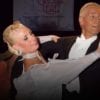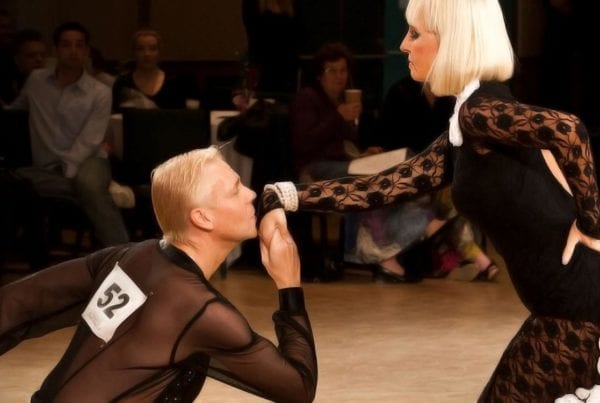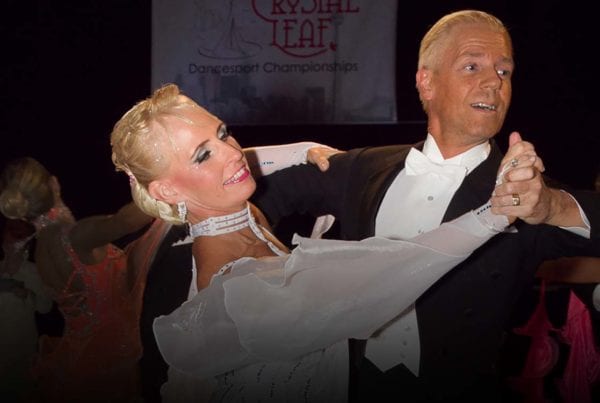Whether you’re a social dancer or competitor (at any level), there are five primary things that seem to come up more often than any other. Here are some tips on how to solve them.

Being blocked
In competition, especially at the higher levels, being blocked is something we encounter all the time. It happens both accidentally and intentionally.
When I was actively competing, I enjoyed blocking guys who I knew got flustered by it, because it allowed me to gain a bit of an upper hand by throwing them off their game. At times we choreograph routines to go deep into corners because that’s where we can best connect in an intimate way with the audience, but it’s also an easy way to get yourself trapped by another couple blocking your way back onto the floor. It also happens when a number of couples end up sharing the same part of the floor, causing what I like to call a “furball” in the corner. You notice this most often in Quickstep or Slow Foxtrot.
In social dancing, it often happens by accident simply because of couples who are at different levels or don’t know how to avoid other couples on the floor.
For both competitors and social dancers, knowing how to handle the block is important. Social dancers can then easily work around the unexpected obstacle with grace, and when it happens in competition you can gain the upper hand by drawing positive attention to your partnership instead of having it focused on the couple blocking you.
There are four main ways to deal with being blocked. Which one you choose depends on the circumstances, but here they are in what is generally considered the order of priority:
Change the energy of the step
In many cases you can deal with a potential block before it happens by simply changing the energy of your step. Slow down the step or speed it up.
You can switch from horizontal energy to vertical energy, shortening the size of the steps along the floor but without losing the energy you’re working with. With this response, you send it upwards instead. This allows you to maintain the beauty of your partnership, because you aren’t throwing the energy away.
Alternatively, you can add more horizontal energy to your step, such as when you see your intended path closing in. Create new power by lowering and driving forward with additional surge of energy to get through the gap before it closes. I remember one Waltz competition where we were about to start a Fallaway Reverse Slip Pivot when I noticed a much shorter Asian couple blocking our intended path as they stopped to perform a Contra Check. I was able to simply lift my energy up a little higher than normal and sweep our arms directly over top of the other couple as we went by just exactly at the moment that they lowered into their picture line. The audience loved it. I’m pretty sure the other couple’s Contra Check was lost in that moment, the audience focused on us instead.
Both partners need to be sensitive to each other. The lady must be able to feel and respond instantly to the intended change of energy, making it look as if both of you thought of the same thing and intended to do it all along.
Change the direction of the step
The second option is to change the direction of your intended step. If you were about to head down the line of dance and a couple gets in your way, make the step diagonal instead. It’s no big deal. You can usually head right back to where you had intended to go with very little difficulty after. Gentlemen, you need to know the alignment for each step pattern in your routine because this is the only way you’ll be able to recover gracefully when you have to make this kind of modification.
Ladies, you need to be ready to feel the lead into a direction that is different from what you are used to, trusting your partner completely that he is intentionally leading you out of trouble so that you can dance more freely.
Change the musicality of the step
The third option is to play with the musicality of a step. Some steps like picture lines or Hover Corte make this easy. You can essentially hold them as long as you want. The Contra Check can not only be held longer, but you can recover and then perform another one immediately after if the obstacle is still there, looking as if it was all part of your intended choreography. Other steps, especially in the Latin dances, make it more difficult but there’s often a way to slow down the musicality in a way that looks completely intentional. Combine it with a more intimate hold for extra impact.
Change the step itself
The last option, the one that’s certainly the most challenging for competitors, is to change the choreography itself. You must have a good partnership for this to work. I recommend that competitors try varying their patterns on a regular basis during competitor practices to get used to sudden switches from the intended choreography to pure lead-follow patterns as a way of learning how to make these changes look seamless. The best competitors develop “step groups” that they can resort to when necessary, allowing the original choreography to resume when the emergency step group is finished.
I recall the SnowBall Classic in Vancouver back in 2005, which was held on an unusual six-sided stage that was not only smaller than typical floors but raised up three feet higher. While all the other competitors played it safe by keeping their choreography some 10 feet back from the edge, Paulo Bosco and Sylvia Pitton of Italy took a very different approach. Instead of using their normal choreography, they used a series of step groups, allowing them to go right to the very edge of the floor. The audience gasped every time they came to the edge. Paulo loved every moment of the energy this caused in the room, and this couple commanded so much attention that you really didn’t even bother watching anyone else. They were electric. I noticed during the initial rounds that the routine was different every time, making it clear that they were not using an actual routine but creating choreography on the fly that fit the unexpected shape of the floor. It was one of the best examples of lead/follow I have ever seen and led to a deep admiration for Sylvia’s incredible ability as a follow.
In the Standard dances, picture lines can make it pretty easy to deal with a block. But I like steps that still have some inherent energy. For example, dancing a Reverse Corte followed immediately by a Closed Impetus is a beautiful combination that has beautiful sway and can be repeated again and again to look energetic and playful. If you’ve been intentionally blocked by a couple doing a more static line, this will put all the attention on you, taking the wind right out of the other couple’s sails. Another useful combination is a Contra Check followed by a Left Whisk, two fun crowd-pleasing picture lines in a row. You can then repeat the same pattern if necessary.
If you’ve been intentionally blocked by a couple doing a more static line, this will put all the attention on you, taking the wind right out of the other couple’s sails.
Changing the choreography is most difficult in the Latin dances and especially the Paso Doble. I recommend that if you dance latin you become intimately familiar with Espana Cani (Spanish Gypsy Dance) so that you can identify without even thinking about it which bar of music you are currently on. That way you can make a change and still be in position for the intended entry into the highlights. A few years ago at the Canadian Championships in Montreal, I watched Canadian champs Anton Belyayev and Antoaneta Popova get blocked by more than one couple in the Paso. Anton effortlessly switched to a Chasses Cape to go around the obstacle and returned to his normal choreography on the other side of the 16-beat pattern. It was a beautiful example of a seamless switch of choreography in the dance that makes this most challenging to do.

When the music seems impossible
In both social and competition settings, dancers often encounter very poor musical choices. The problem is that many dance music DJs, including those hired for major events, are not actually dancers or have not been trained in the nuances of dance musicality or character of dances. I’ve been to competitions where musical choices were made that left me wondering what the DJ was drinking. Or thinking. Angry Quickstep music. Slow Foxtrot with none of the smooth, striding character of that dance. Viennese Waltzes with heavy, square beat patterns. In fact, most Viennese Waltzes played today are not genuine VWs. Just because a dance has 3/4 time in the right count of measures per minute does not really make it a Waltz.
My personal pet peeve is competition DJs who are, in their own words, “tired of hearing the same dance music” and play unexpected choices at competitions. The couples dancing might each spend up to $60,000 annually preparing to put their very best dancing on the floor only to have their efforts hijacked by a selfish DJ who wants to play “something nobody has heard before” instead of a proper dance tune. But it happens and you need to be ready.
Other issues might also pop up. During a Senior 1 Ten Dance World Championship the DJ played a Slow Foxtrot that measured just 24 bars per minute. It was a practice tune I recognized from a Dancelife CD. Struggling to deal with this glacially slow Foxtrot I wondered why the Chair of Judges didn’t stop the music only to learn later that they tried, only to be informed that the song had been licensed for television and couldn’t be changed. This stuff happens and you need to be prepared for it.
I wondered why the Chair of Judges didn’t stop the music only to learn later that they tried, only to be informed that the song had been licensed for television and couldn’t be changed
The most important thing in dancing musically is to know where the “1” count is. As long as you are clearly aware of the 1 in the music, you can dance pretty well any dance to any music. You can dance Waltz or Slow Foxtrot to a Rumba Tune. You can dance Cha Cha to Tango music. Of course, you won’t be able to fully realize the qualities of the choreography or the dance in those situations because doing so requires music that matches the choreography, but all the other couples on the floor will be in the same boat. If you can deal with it better than the others, you’ll be the star of the moment.
The best and most musical dancers will not only be able to work within that unexpected music, they will still be able to add their own musical interpretation on top of it all, making it their distinct story. Practice by dancing your routine to different types of music, including some that simply feels wrong so that it doesn’t throw you when it actually happens to you for real.

When the Lead goes blank
Of course this never happens. Sure. Never. I remember a few years ago when the couple that won the Canadian Championship in a Latin event took the floor to do their honor dance, only to have the lead go completely blank just as the dance started. It was a Jive. He regrouped and tried again. Still couldn’t get it going. As nearly a thousand people watched this single couple on the floor, the pressure must have been immense after two false starts. Then there was yet a third false start. I can’t even imagine what they must have gone through mentally. Eventually they were able to get past it.
The point is that going blank can happen to any lead. It has happened to me. I’m convinced that if you ask 10 guys if they have ever gone blank while dancing, 8 will say yes and 2 will lie.
I’m convinced that if you ask 10 guys if they have ever gone blank, 8 will say yes and 2 will lie
When the lead does go blank, the follow must ensure that she doesn’t add additional pressure by showing tension or frustration. She needs to remain calm and graceful through it, allowing him to deal with it in his own way. For social dancers in Latin this is usually fairly easy to deal with. Ladies should just keep dancing the basic. The gentleman will then be aware of the step patterns and this will help him prepare to lead something new.
In the Standard dances the lady has no choice but to remain connected, so her role is to avoid switching feet or doing something else that will make it hard for the lead to carry on. I recommend that social dancers or Standard competitors in the syllabus levels simply move into a step that can provide some additional thinking time. A Hesitation in Waltz or Quickstep. A Change of Direction in Slow Foxtrot. A Promenade Link in Tango. Once in that position, just hold your place until you have mapped out what you want to do next. Don’t forget to keep some kind of active energy so that the hold doesn’t look too static. Then make sure your partner is on the right foot and lead the next step clearly.

When the Follow doesn’t do what was led
Again, I’m sure this has never happened to anyone. Right? Leading is a continual process of giving a signal and then responding to how the signal was interpreted. At times, it could happen that the signal was less than ideal, misunderstood or given late and the lady does something different than what was intended. The lead then needs to be ready with a response to ensure that it looks intentional. My personal view is that the job of a Lead is to make the lady the hero of the dance. If she does something unexpected, he needs to be prepared to do whatever it takes so that she looks and feels good.
My personal view is that the job of a Lead is to make the lady the hero of the dance
In my experience, the most common issue is when the gentleman leads a closing action at the end of a Standard step and the lady opens to Promenade. Alternatively, he might lead a Promenade ending and she decides to close. It can happen even with a great lead, if the lady is used to opening after that particular step pattern. If he intended a Promenade and she closes, the issue is barely even a problem. Handling it is easy. If the lady opens to Promenade it can create a challenge because she is now facing across his body while he is planning to step across her path. In this case, the man must switch to a lateral step that goes in the same direction as the lady is now moving. For example, you could switch from your planned Natural Turn into a Chasse and then do the Natural Turn after that. This allows the movement to go in the same direction that the lady was already traveling, making it look quite smooth and intentional.
In the Latin dances, switch back to a basic movement and then begin a new step, typically repeating something you just did moments earlier so that the lady understands what might have gone wrong.
These are the most common problems that ballroom dancers encounter, with some helpful tips. If you’ve run into them or have your own favorite solutions, chime in and share your thoughts using the comment area below.











